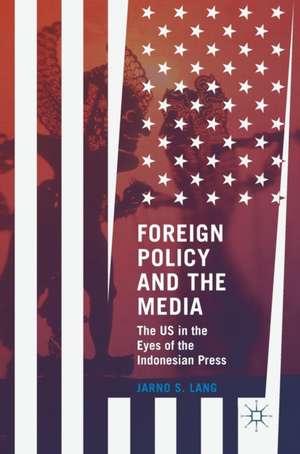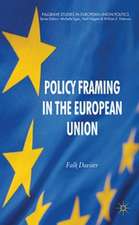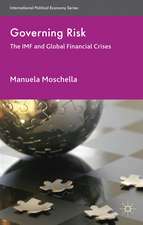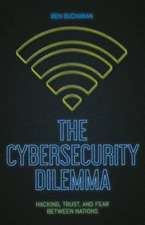Foreign Policy and the Media: The US in the Eyes of the Indonesian Press
Autor Jarno S. Langen Limba Engleză Hardback – 27 sep 2016
| Toate formatele și edițiile | Preț | Express |
|---|---|---|
| Paperback (1) | 384.48 lei 6-8 săpt. | |
| Palgrave Macmillan UK – 14 iun 2018 | 384.48 lei 6-8 săpt. | |
| Hardback (1) | 389.31 lei 6-8 săpt. | |
| Palgrave Macmillan UK – 27 sep 2016 | 389.31 lei 6-8 săpt. |
Preț: 389.31 lei
Nou
Puncte Express: 584
Preț estimativ în valută:
74.50€ • 77.98$ • 62.00£
74.50€ • 77.98$ • 62.00£
Carte tipărită la comandă
Livrare economică 31 martie-14 aprilie
Preluare comenzi: 021 569.72.76
Specificații
ISBN-13: 9781137594938
ISBN-10: 1137594934
Pagini: 248
Ilustrații: XVII, 255 p.
Dimensiuni: 148 x 210 x 21 mm
Greutate: 0.45 kg
Ediția:1st ed. 2016
Editura: Palgrave Macmillan UK
Colecția Palgrave Macmillan
Locul publicării:London, United Kingdom
ISBN-10: 1137594934
Pagini: 248
Ilustrații: XVII, 255 p.
Dimensiuni: 148 x 210 x 21 mm
Greutate: 0.45 kg
Ediția:1st ed. 2016
Editura: Palgrave Macmillan UK
Colecția Palgrave Macmillan
Locul publicării:London, United Kingdom
Cuprins
Acknowledgements.- Introduction The Relevance of the Indonesian-American Relations.- 1. Theoretical Perspectives – A Lens through which to View the World.- 1.1 Zone of Collaboration? Southeast Asian Area Studies and Political Science.- 1.2 Interpretivist Social Constructivism as a Research Perspective.- 1.3 Power and Social Constructivism.- 1.4 Images in International Relations.- 1.5 Media Power in Societies.- 1.6 Threat and Opportunity.- 2. A Research Design for a Qualitative Image Study.- 2.1 Triangulation as a Research Strategy.- 2.2 The Sources of Data.- 2.2.1 Tertiary Source: Statistical Data on the US Image in Indonesia 2.2.2 Secondary Source: Expert Interviews.- 2.2.3 Primary Source: Expert Interviews.- 2.3 Analysis of the Primary Source Data.- 2.3.1 US Foreign Policy Image in the Indonesian Press: Decisions Involved.- 2.3.2 Diverse Cases Design.- 2.3.3 Deconstructing Press Articles: Content and Critical Discourse Analysis.- 2.3.4 Enacting the Process of Analysis.- 3. The Indonesian Press and US-Indonesian Relations.- 3.1 The Press in Indonesia - History and Contemporary Situation.- 3.1.1 Is there an Asian-Pacific Culture of Journalism?.- 3.1.2 The Social Embededness of the Southeast Asian Media.- 3.1.3 The Development of the Indonesian Press.- 3.2 The US and Indonesia - A History of Ups and Downs.- 3.2.1 US Foreign Policy toward Southeast Asia up to the 21st century.- 3.2.2 The Development of Indonesian Self Image and Foreign Policy.- 3.2.3 Indonesia's Place on the International Stage Post-Suharto and the Post-1998 Rapprochement of the US.- 3.3 From Bush to Obama: The US in Indonesia and Indonesia's Self Image.- 3.3.1 General Image of the US in Indonesia (2001-2013).- 3.3.2 The Obama Factor.- 3.3.3 The Indonesian International Outlook and Self-Image.- 3.3.4 US vs. China and the Global Balance of Power.- 4. The Three Steps of Analysis.- 4.1 The First Step: Identifying the Empirical Frames and Categories.- 4.2 The Second Step: 1st Round of Coding the Primary Data - Issues and Tendencies.- 4.2.1 The Three Sets of Codes: Empirical References, Theoretical Categories and Press Reactions.- 4.2.2 The Numerical Tendencies: Three Phases of Perception.- 4.2.3 Overview after First Round of Coding: Numerical Dominance of Critical and Balanced Codes.- 4.3 The Third Step: 2nd Round of Coding the Primary Data - Discourse Analysis.- 5. Empirical Frame I – The US in Southeast Asia.- 5.1 Case No. 1: The Jakarta Post.- 5.1.1 Importance of US-Indonesian Relations.- 5.1.2 US vs. China.- 5.1.3 The US and Counterterrorism in Southeast Asia.- 5.2 Case No. 2: Kompas.- 5.2.1 Importance of US-Indonesian Relations.- 5.2.2 US vs. China.- 5.2.3 The US and Counterterrorism in Southeast Asia.- 5.3 Case No. 3: Republika.- 5.3.1 Importance of US-Indonesian Relations.- 5.3.2 US vs. China.- 5.3.3 The US and Counterterrorism in Southeast Asia.- 5.4 Case No. 4: Suara Hidaytullah.- 5.4.1 Importance of US-Indonesian Relations.- 5.4.2 The US and Counterterrorism in Southeast Asia.- 5.5 Conclusion Empirical Frame I: Mixed Discursive Positions.- 6. Empirical Frame II – The US in the ‘Arab World’.- 6.1 Case No. 1: The Jakarta Post.- 6.1.1 Afghanistan Invasion.- 6.1.2 Iraq Invasion.- 6.1.3 US Support for Israel.- 6.2 Case No. 2: Kompas.- 6.2.1 Afghanistan Invasion.- 6.2.2 Iraq Invasion.- 6.2.3 US Support for Israel.- 6.3 Case No. 3: Republika.- 6.3.1 Afghanistan Invasion.- 6.3.2 Iraq Invasion.- 6.3.3 US Support for Israel.- 6.4 Case No. 4: Suara Hidaytullah.- 6.4.1 Afghanistan Invasion.- 6.4.2 Iraq Invasion.- 6.4.3 US Support for Israel.- 6.5 Conclusion Empirical Frame II: The US as a Threat.- 7. Empirical Frame III – The US Globally.- 7.1 Case No. 1: The Jakarta Post.- 7.1.1 War on Terror.- 7.1.2 US Global Hegemony.- 7.2 Case No. 2: Kompas.- 7.2.1 War on Terror.- 7.2.2 US Global Hegemony.- 7.3 Case No. 3: Republika.- 7.3.1 War on Terror.- 7.3.2 US Global Hegemony.- 7.4 Case No. 4: Suara Hidaytullah.- 7.4.1 War on Terror.- 7.4.2 US Global Hegemony.- 7.5 Conclusion Empirical Frame III: American Global Imperialism?.- Conclusion: The US in the Indonesian Press – Between Threat and Opportunity
Recenzii
“This book is arguably a pioneer in the field of media studies. … The most important contribution of this study lies in its ability to show clearly the link between the media, public opinion and foreign policy.” (Wijayanto, Contemporary Southeast Asia, Vol. 39 (2), August, 2017)
Notă biografică
Jarno S. Lang works for the NGO Arbeiter-Samariter-Bund and is a Reporter for Fair Observer. He holds an MA from the University of Heidelberg, Germany, in the humanities and a PhD in International Relations from the University of Freiburg, Germany. During his studies for this book, he was able to combine his personal and professional interests in Southeast Asia.
Textul de pe ultima copertă
This book analyzes the response of the Indonesian press to American foreign policy during the administrations of Presidents Bush and Obama. Situated in Southeast Asia, Indonesia is the world’s fourth most populous country and the largest Muslim nation, and as such is a potentially vital economic and strategic partner to the US in the 21st century. Ever since Indonesian independence post World War II, relations to the US have been marked by ups and downs. The author argues that the way the Indonesian public perceives the world has an impact on the national self-image that again heavily influences national foreign affairs. For both the US and Indonesia, this is a crucial moment in bilateral relations. This study explores Indonesian media responses to American foreign policy by analyzing more than 400 press articles. In the context of President Obama’s declared “pivot to Asia”, both countries need to find a way to foster better relations.
Jarno S. Lang works for the NGO Arbeiter-Samariter-Bund and is a Reporter for Fair Observer. He holds an MA from the University of Heidelberg, Germany, in the humanities and a PhD in International Relations from the University of Freiburg, Germany. During his studies for this book, he was able to combine his personal and professional interests in Southeast Asia.
Jarno S. Lang works for the NGO Arbeiter-Samariter-Bund and is a Reporter for Fair Observer. He holds an MA from the University of Heidelberg, Germany, in the humanities and a PhD in International Relations from the University of Freiburg, Germany. During his studies for this book, he was able to combine his personal and professional interests in Southeast Asia.
Caracteristici
Explores the turbulent Indonesian-American history in the 21st century
Examines the Indonesian press responses to American foreign policy during the Bush and Obama administrations
Provides the first authoritative review of how the perception of American foreign policy changes in the Indonesian press over time using analysis of over 400 press articles
Examines the Indonesian press responses to American foreign policy during the Bush and Obama administrations
Provides the first authoritative review of how the perception of American foreign policy changes in the Indonesian press over time using analysis of over 400 press articles














